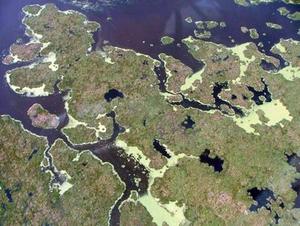Infrastructure protectionWetland preservation is good business
A recently published study is making the case for wetland preservation by highlighting the economic incentives that such preservation could provide to urban centers.Infrastructure investment in urban waterfronts could soon be seen as one of the best economic decisions a city could make. The National Oceanic and Atmospheric Administration says that “$1 million invested in coastal restoration creates 17.1 jobs, compared to just 8.9 jobs for every $1 million invested in oil and gas development.”

Wetlands generate business through preservation efforts // Source: psu.edu
A recently published paper from Oxfam America and the Center for American Progress is making the case for wetland preservation by highlighting the economic incentives that such preservation could provide to urban centers.
As Fast Company reports, new perspectives on infrastructure investment in urban waterfronts could soon be seen as one of the best economic decisions a city could make. The magazine points out that “many smart people think we should be investing in coastal wetlands that can act like ‘horizontal levees’ around cities. By impeding onrushing water, these natural habitats can help limit the damage from future storms when they inevitably occur.”
These revelations arrive in the light of contemporary American urban disasters such as the destruction to the East Coast from Hurricane Sandy, with an eventual cost of $100 billion, according to a January 2013 USA Today report.
Fast Companysummarized many of the points of the study, which includes the fact that wetlands are disappearing despite federal mandate, the protection benefits of such coastal marshes, their ability to reduce urban pollution, and the inevitable job creation benefits.
It mentions a 1989 White House policy of “no net loss” to wetlands in the United States, despite the opposite trend, as well as another study that found that “the loss of one hectare of wetland equates to $33,000 in storm damage, and that existing wetlands provide protection worth between $250 and $51,000 per year.”
On top of that, it was found “that major wetlands take out 5.8 million metric tons of nitrogen before runoff reaches drinking water…Another study estimates that wetlands prevent $13 Billion in annual nitrogen pollution.”
Most interesting perhaps to economic and development drivers is the news from the National Oceanic and Atmospheric Administration that “$1 million invested in coastal restoration creates 17.1 jobs, compared to just 8.9 jobs for every $1 million invested in oil and gas development.”
